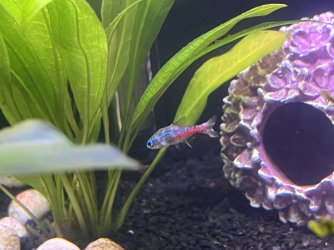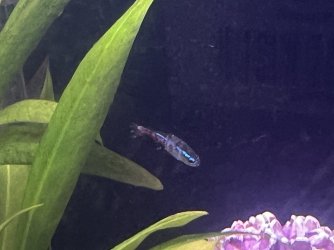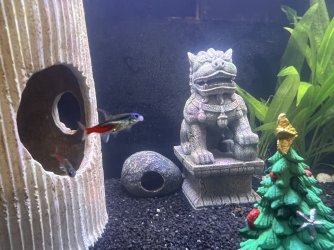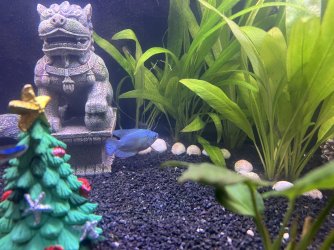The neon tetra with the white lump on the bottom lip has what I consider to be a virus that is reasonably new to science and has been showing up during the last 2 years. The fish continue to swim and eat normally and should be left alone until it can't eat or swim properly, then euthanised.
-------------------
The neon tetra with the white stuff on the body is suffering from an internal issue (probably intestinal worms and or gill flukes) and is covered in excess mucous. The mucous is produced by the fish when it is irritated by something in the water (ammonia, nitrite, nitrate, incorrect pH or an external parasite).
If the water quality is good (0 ammonia, 0 nitrite, less than 20ppm nitrate, pH around 6.0 to 7.5) then it is either from the medication or an external protozoan infection.
Did the white stuff on the neon show up before or after you added the Melafix & Pimafix?
I'm assuming before you treated and this would support poor water quality or an external protozoan infection.
Poor water quality can be treated by doing big (75%) water changes and gravel cleaning the substrate every day for a week (or more if required).
Some external protozoan infections can be treated with salt, (see directions below).
-------------------
The blue gourami is probably stressed from the Melafix and Pimafix. These medications leave an oily film on the surface and labyrinth fishes (Bettas & gouramis) regularly take air from the surface. If there is oil on the surface the fish get that on the labyrinth organ and gills and it can kill them or cause them to have trouble breathing. Clean water (big daily water changes) and surface movement (aeration) should help.
-------------------
What to do now.
Test the water for ammonia, nitrite, nitrate and pH.
Wipe the inside of the glass down with a clean fish sponge. This removes the biofilm on the glass and the biofilm will contain lots of harmful bacteria, fungus, protozoans and various other microscopic life forms.
Do a 75% water change and gravel clean the substrate every day for a week. The water changes and gravel cleaning will reduce the number of disease organisms in the water and provide a cleaner environment for the fish to recover in. It also removes a lot of the gunk and this means any medication can work on treating the fish instead of being wasted killing the pathogens in the gunk. If there's a water quality issue, the water changes will dilute the harmful nutrients (ammonia, nitrite & nitrate).
Make sure any new water is free of chlorine/ chloramine before it is added to the tank.
Clean the filter if it hasn't been done in the last 2 weeks. However, if the filter is less than 6 weeks old, do not clean it. Wash the filter materials/ media in a bucket of tank water and re-use the media. Tip the bucket of dirty water on the garden/ lawn. Cleaning the filter means less gunk and cleaner water with fewer pathogens so any medication (if needed) will work more effectively on the fish.
Increase surface turbulence/ aeration to maximise the dissolved oxygen in the water.
If there's no improvement in the neon tetra covered in mucous after a week, add some salt and maybe look at deworming the fish. You can use deworming medications and salt at the same time.
Section 3 of the following link has info on deworming fish.
Fish do a stringy white poop for several reasons. 1) Internal Bacterial Infections causes the fish to stop eating, swell up like a balloon, breath heavily at the surface or near a filter outlet, do stringy white poop, and die within 24-48 hours of showing these symptoms. This cannot normally be...

www.fishforums.net
-------------------
SALT
You can add rock salt (often sold as aquarium salt), swimming pool salt, or any non iodised salt (sodium chloride) to the aquarium at the dose rate of 1 heaped tablespoon per 20 litres (5 gallons) of water. If there is no improvement after 48 hours you can double that dose rate so there is 2 heaped tablespoons of salt per 20 litres.
Keep the salt level like this for at least 2 weeks but no longer than 4 weeks otherwise kidney damage can occur. Kidney damage is more likely to occur in fish from soft water (tetras, Corydoras, angelfish, Bettas & gouramis, loaches) that are exposed to high levels of salt for an extended period of time, and is not an issue with livebearers, rainbowfish or other salt tolerant species.
The salt will not affect the beneficial filter bacteria, fish, plants, shrimp or snails.
After you use salt and the fish have recovered, you do a 10% water change each day for a week using only fresh water that has been dechlorinated. Then do a 20% water change each day for a week. Then you can do bigger water changes after that. This dilutes the salt out of the tank slowly so it doesn't harm the fish.
If you do water changes while using salt, you need to treat the new water with salt before adding it to the tank. This will keep the salt level stable in the tank and minimise stress on the fish.
When you first add salt, add the salt to a small bucket of tank water (about 2 litres) and dissolve the salt. Then slowly pour the salt water into the tank near the filter outlet. Add the salt over a couple of minutes.







